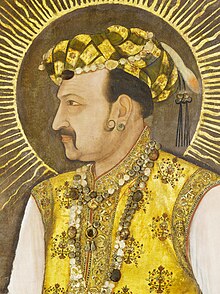
Back نور الدين جهانكير Arabic نور الدين جهانكير ARZ Sultan Cahangir Azerbaijani جهانگیرشاه AZB Jahangir BCL Джахангір Byelorussian Джахангир Bulgarian जहाँगीर Bihari জাহাঙ্গীর Bengali/Bangla Jahangir Breton
| Jahangir | |||||||||||||||||
|---|---|---|---|---|---|---|---|---|---|---|---|---|---|---|---|---|---|
| Padishah Al-Sultan al-Azam Shahenshah-e-Hind (King of Kings of India) | |||||||||||||||||
 Portrait by Abu al-Hasan, c. 1617 | |||||||||||||||||
| Emperor of Hindustan | |||||||||||||||||
| Reign | 3 November 1605 – 28 October 1627 | ||||||||||||||||
| Coronation | 24 November 1605 | ||||||||||||||||
| Predecessor | Akbar I | ||||||||||||||||
| Successor | Shah Jahan Shahryar Mirza (de facto) Dawar Bakhsh (titular) | ||||||||||||||||
| Born | Nur-ud-din Muhammad Salim 31 August 1569 Fatehpur Sikri, Agra Sarkar, Agra Subah, Mughal Empire[1] (modern-day Fatehpur Sikri, Agra district, Uttar Pradesh, India) | ||||||||||||||||
| Died | 28 October 1627 (aged 58) Bhimber, Kashmir Sarkar, Kabul Subah, Mughal Empire (modern-day Bhimber, Bhimber district, Azad Jammu and Kashmir, Pakistan) | ||||||||||||||||
| Burial | Tomb of Jahangir, Lahore, Pakistan | ||||||||||||||||
| Consort | |||||||||||||||||
| Wives more... | |||||||||||||||||
| Issue more... | |||||||||||||||||
| |||||||||||||||||
| House | House of Babur | ||||||||||||||||
| Dynasty | Timurid | ||||||||||||||||
| Father | Akbar | ||||||||||||||||
| Mother | Mariam-uz-Zamani | ||||||||||||||||
| Religion | Sunni Islam[6][7] (Hanafi) | ||||||||||||||||
| Imperial Seal |  | ||||||||||||||||
Nur-ud-din Muhammad Salim[8] (31 August 1569 – 28 October 1627),[9] known by his imperial name Jahangir (Persian pronunciation: [d͡ʒa.hɑːn.ˈɡiːɾ]; lit. 'Conqueror of the World'),[10] was Emperor of Hindustan[11][12] from 1605 until his death in 1627, and the fourth Mughal Emperor.
Born as Prince Salim, he was the third and only surviving son of Emperor Akbar and his chief empress, Mariam-uz-Zamani. Akbar's quest for a successor took him to visit the Hazrat Ishaan and Salim Chishti, Sufi saints who prophesied the birth of three sons. Jahangir's birth in Fatehpur Sikri was seen as a fulfillment of Chishti's blessings, and he was named after him. His early life was marked by personal tragedy, including the death of his twin brothers in infancy, which led to a sense of grief in his family. His early education was comprehensive, covering various subjects including Persian, Hindustani, and military tactics. Jahangir's upbringing was heavily influenced by the cultural and spiritual heritage of his family, setting the stage for his later rule as emperor.
His reign was marked by a combination of artistic achievement and political intrigue, set against the backdrop of the Mughal Empire's considerable expansion and consolidation. Jahangir's rule is distinguished by his commitment to justice and his interest in the arts, particularly painting and architecture, which flourished during his reign. Jahangir's reign was characterized by a complex relationship with his nobility and family, notably reflected in his marriage to Mehar-un-Nisa (later known as Empress Nur Jahan), who wielded significant political influence behind the throne. This period saw the empire's further entrenchment into the Indian subcontinent, including efforts to subdue the Rajput Kingdoms and extend Mughal authority into the Deccan. Jahangir's foreign policy included interactions with the Safavids of Persia and the Ottoman Empire, as well as with the English East India Company, marking the beginning of European influence in Indian politics and commerce.
Despite his achievements, Jahangir's reign had challenges, including revolts led by his sons, which threatened the stability of his rule. His poor health, caused by a lifetime of opium and alcohol use, led to his death in 1627, precipitating a brief succession crisis before the throne passed to his son, Shah Jahan. Jahangir's legacy lives on through his contributions to Mughal art and architecture, his memoirs, and the policies he implemented, which continued to influence the empire after his demise.
- ^ Henry Beveridge, Akbarnama of Abu'l Fazl Volume II (1907), p. 503
- ^ Emperor of India, Jahangir (1999). The Jahangirnama: memoirs of Jahangir, Emperor of India. Translated by Thackston, W. M. Washington, D. C.: Freer Gallery of Art, Arthur M. Sackler Gallery, Smithsonian Institution; New York: Oxford University Press. p. 12. ISBN 978-0-19-512718-8.
- ^ Trimizi, S. A. I. (1989). Mughal Documents. Manohar. p. 31.
- ^ Sarkar, Jadunath (1952). Mughal Administration. M. C. Sarkar. pp. 156–57.
- ^ a b c Foster, Sir William (1975). Early travels in India, 1583-1619. AMS Press. pp. 100–101. ISBN 978-0-404-54825-4.
- ^ Andrew J. Newman, Twelver Shiism: Unity and Diversity in the Life of Islam 632 to 1722 (Edinburgh University Press, 2013), online version: p. 48: "Jahangir [was] ... a Sunni."
- ^ John F. Richards, The Mughal Empire (Cambridge University Press, 1995), p. 103
- ^ Singh, Pashaura; Fenech, Louis E., eds. (2014). The Oxford handbook of Sikh studies. Oxford University Press. p. 647. ISBN 978-0-19-969930-8.
- ^ "Jahangir | Ruler, Biography, Administration, & Achievements". www.britannica.com. 19 June 2023. Archived from the original on 24 July 2018. Retrieved 8 July 2023.
- ^ "Jahāngīr". Encyclopædia Britannica. Archived from the original on 24 July 2018. Retrieved 2 June 2018.
- ^ Journal of Historical Research. 1983. p. 80.
Jahangir became the Emperor of Hindustan. However, Jahangir could not place absolute reliance on the old nobility
- ^ Versha Gupta (27 July 2018). Botanical Culture of Mughal India. Partridge. p. 75. ISBN 978-1-5437-0336-8.
Kashmir was Jahangir's first love always. First time he visited along Kashmir with his father in 1589. He had scholarly instinct and love of nature. After he became the emperor of Hindustan, he visited the happy valley for a number of times for enjoying the cool and refreshing air of the valley